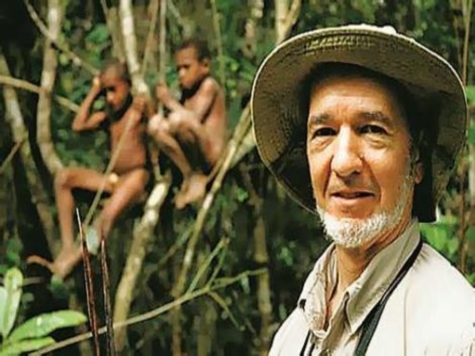
A historical thesis popularized by Jared Diamond, author of Guns, Germs and Steel,postulates that the tiny and remote Easter Island suffered adevastating ecological collapse as the result of poor stewardship ofnatural resources by its inhabitants. Diamond goes on to suggest thisbeen challenged by a pair of archaeologists working to investigate thereal history of Easter Island.
In a new book titled The Statues That Walked, Carl Lipo and Terry Hunt argue that the story of the downfall of Easter Island as popularized in Diamond’s 2005 book Collapse: How Societies Choose to Fail or Succeed is almost completely false. Collapseoffers a series of metrics by which Diamond claims we can evaluate andpredict when societies are likely to collapse. About half of his effortin Collapse is actually spent retrodicting (applying his views to historical situations) to demonstrate the connection between ecological stress and societal collapse. Perhaps the moststriking example Diamond offers is the ecocide (ecological suicide) which transformed Easter Island from a dense tropical forest to a land barren of trees.
Diamond’s case ties the destruction of the island’s trees to theconstruction of the massive stone monuments for which the island isfamous. He argues the inhabitants likely used up the trees in order tobuild ladder-like wooden roadwaysalong which the multi-ton statues could be dragged. Once the trees weregone, there was no way to replenish them. In Diamond’s telling, thisecological change led the various tribes which shared the island intofactional warfare and, eventually, cannibalism. He concludes his recounting of Easter Island’s history by suggesting it may be a harbinger of things to come:
The parallels between Easter Island and the whole modern world arechillingly obvious. Thanks to globalization, international trade, jetplanes, and the Internet, all countries on Earth today share resourcesand affect each other, just as did Easter’s dozen clans. PolynesianEaster Island was as isolated in the Pacific Ocean as the Earth is todayin space. When the Easter Islanders got into difficulties, there wasnowhere to which they could flee, nor to which they could turn for help;nor shall we modern Earthlings have recourse elsewhere if our troublesincrease. Those are the reasons why people see the collapse of EasterIsland society as a metaphor, a worst-case scenario, for what may lieahead of us in our own future.
In the final section of his book, Diamond returns to Easter Islandrepeatedly as an example of destructive choices made to suit religious (or industrial) needs:
Religious values tend to be especially deeply held and hencefrequent causes of disastrous behavior. For example, much of thedeforestation of Easter Island had a religious motivation: to obtainlogs to transport and erect the giant stone statues that were the object of veneration.
Diamond’s book really amounts to a sustained argument for greaterecological awareness. He closes on a note of hope, because we have theability to learn from past mistakes, including those on Easter Island.But Diamond’s assessment of past mistakes have now been called intoquestion. New research suggests there was no ecological collapse onEaster Island. No warfare. No cannibalism. There was deforestation andmankind certainly aided that over time but, in all probability, therewas another culprit: destructive, tree-dwelling rats:
Everyone agrees that Easter Island was almostcompletely deforested by the time Europeans first visited in 1722. Thekey issue is causation…As the evidence shows and as we argued in our book, deforestation was acumulative process that took centuries. It resulted from rat predationof seeds and from people using fire to clear vegetation for agriculture.
The authors of The Statues That Walked also undermineDiamond’s central claim that Easter Island’s religion and heavy industry(building giant statues) led to deforestation:
Diamond’s collapse thesis relies heavily on how the statues weremoved. To sustain his thesis regarding the eventual “collapse” of theancient society, he needs statue movement to be the “engine” that causedthe loss of trees. Decouple the loss of trees from moving statues andthe “collapse” story looses steam. Thus, we are not surprised thatDiamond holds so tenaciously to old beliefs and discredited claims…
In recent experiments funded by NationalGeographic and fully filmed, we “walked” a multi-ton replica of anactual statue (one found along an ancient transport road). Moving astatue in a standing position is not only possible; it’s relatively easyand can be done with a small group of people using only ropes.
There is also new evidence that the society on Easter Island never devolved into warfare and cannibalism as Diamond claimed:
Diamond’s “preserved weapons,” the mata’a, are agriculturaltools that he has chosen to describe as “weapons.” Their design alone, arounded to irregular shape, should have been enough to make himquestion their purpose. But if he had read the microscopic studiesreporting edge damage on thousands of these artifacts, he would haveseen that the damage they show is consistent with their role in cuttingand scrapping plant material (e.g., Church and Ellis 1994).
While Jared Diamond intended the “collapse” of Easter Island to be awarning of possible ecological collapse for our world, theauthors of The Statues That Walked suggest an entirely different lesson which one might take from Diamond’s misreading of the evidence:
rather than repeat assumptions and claims made in the past, we soughtdirect evidence with no preconceived ideas we needed to defend. In thatframe of mind, what the evidence kept pointing to is that many of theover and over and nothing more.
There was deforestation on Easter Island. That’s a fact. But Diamondappears to have seen Easter Island as a useful ecological parable,rather than as an open archaeological question. That is an error wecan all learn from.

COMMENTS
Please let us know if you're having issues with commenting.